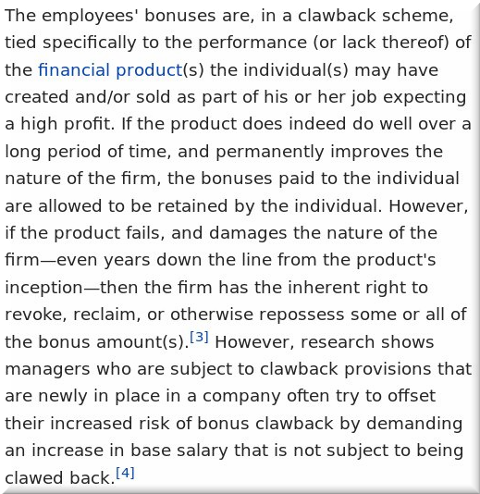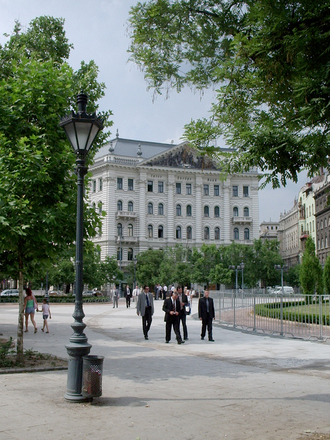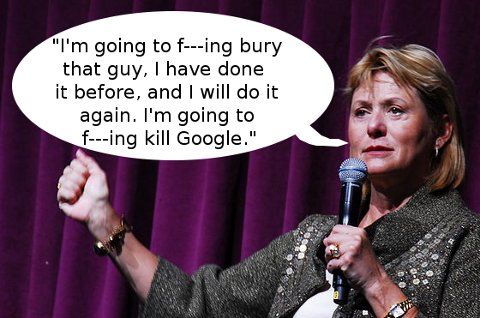08.15.16
Posted in Europe, Finance, Patents at 4:34 am by Dr. Roy Schestowitz
Clawback under Battistelli assures reduction in quality of staff (reduction in patent quality aside)

Summary: Staff of the EPO is leaving (or retiring) in droves as abusive management continues to be the norm and staff benefits are being taken away or gradually revoked
CRACKDOWNS at the EPO carry on, even when staff is (mostly) on holiday. Don’t be misled by the silence. Things are not rosy at all. Some representatives appear to have gotten exhausted, whereas others are too afraid or away on holiday. Some are on permanent leave or effectively suspended. In the coming weeks we shall reveal some more information, potentially about individual stories as well. It’s not pretty and it serves to show what kind of management runs the European Patent Office these days. Rather than value staff, this management does a fine job driving staff away. Cherishing and respecting people (“assets” or “human resources” as management typically refers to them) is the key to an institution’s long-term success. Highly educated people have plenty of employment options, so they don’t tolerate abuse from their superiors. They have other career possibilities (private and public sectors) and they tend to be principled, not judgmental or overly opinionated. They also know their rights and actively defend these.
“Rather than value staff, this management does a fine job driving staff away.”Earlier this year we mentioned the attack on the pension of Els Hardon — probably an illegal move which Battistelli later had to withdraw/revoke. What kind of justice is that? Hardon was dismissed from the Office for her duties as a staff representative and she wasn’t alone. It is very sad that Battistelli’s war on the staff union left much-appreciated staff having to support their representatives with Broodfonds (literally bread funds). Some of them have entire families to support! What happened to human decency?
The crackdown is far from over as EPO management, notably Bergot (the wife of Battistelli’s former INPI colleague), still threatens staff representatives, even while they’re on holiday. Mr. Topić, for instance, blocked the publication of essential reading material in The Hague, without even notifying the Local Staff Committee The Hague. This was censored using threats of disciplinary measures. So the atmosphere of fear clearly prevails at the EPO and people are rightly afraid of communicating with one another. That’s a recipe for disaster that would certainly drive away the high-profile examiners. They would have no problem seeking and finding alternative employment, e.g. in fine universities or in the industry.
“Cherishing and respecting people (“assets” or “human resources” as management typically refers to them) is the key to an institution’s long-term success.”EPO management, moreover, is trying to punish strikers (perfectly lawful activity) even more severely. The management is getting pretty vicious right now, raising the ‘fine’ by 50% by essentially withdrawing a twentieth (instead of a thirtieth) of one’s salary. They are just taking away more and more of people’s money, so no wonder people flee or formally retire early. Watch what they’re doing to people’s investments, pension changes aside. Based on this document [PDF], workers’ interests are trampled and stomped on. Quoting from the summary in the PDF: “lowering the probability of reaching the long-term objective for the investment returns, but instead supported initially unfounded and expensive reforms.”
“Therefore,” it also says, “the Office representative’s reasoning appears to be so ill-founded and misaligned with the interests of the main stake-holders that one might conclude that it serves instead to realise another hidden (or at least undisclosed) agenda.”
There is also a part about Bergot: “Further statements made by Ms. Bergot left Staff representatives with the impression that the Office may also try to influence the investment return assumptions made by the three independent actuaries of the AAG. If successful, this might lead to pushing for a reduction in the assumed rate of return on investment in the actuarial study, which could consequently trigger a recommendation by the actuaries either to increase the contributions which the Office could follow and/or lower the benefits.”
“A lot of people are leaving.”“Unfortunately,” they conclude, “whatever the outcome, it is the staff (and only the staff) who will have to pay the bill.”
Well, they might not stick around to even pay the bill. A lot of people are leaving. Consider the aforementioned changes to pensions, which came under criticism in a report commissioned by SUEPO. These pension changes were recently assessed in a legal opinion (mentioned [PDF] here before [PDF]) and it’s just one among all sorts of ‘reforms’ that breach the fundamental rules and treat staff like dispensable machine operators. The EPO apparently suffers from a lack of money, as it is operating at a massive loss, which makes one wonder if the pensions will be reduced or become some kind of a Ponzi scheme one day. Later this summer we are going to give more examples of where money gets wasted by the millions (for little and sometimes no benefit/gain). Battistelli is terrible on fiscal terms and even some delegates openly speak about it nowadays (a subject to be explored in depth another day). Some say there is even financial fraud.
“What will their retirement mean in terms of pensions?”The brain drain at the EPO is measurable and it is not a matter of ‘gut feeling’ or intuition. One report we saw gives us a rough idea of who left (or is leaving) other than top management. The report says that numbers are made apparent from the EPO’s own reports. To quote: “The social report shows that the Office could not maintain staffing levels at their overall target despite a vigorous recruitment campaign. 2015 saw a net decrease of 77 staff members; in particular the BoA saw a reduction of 15. Furthermore, there were no new recruits from a number of countries including Sl, CZ, CH, NO, and GB. While up to 2014 typically around 100 staff members would retire, in 2015 this number had nearly doubled. The average retirement age has also decreased from around 63 years to about 61 years.”
What will their retirement mean in terms of pensions? Well, to be frank, I’m no accountant and my knowledge regarding accounting is scarce, but the subject was recently explored in IP Kat comments. For record and future reference, here is what one person wrote about the pensions:
The benefits are not over-generous. I can explain the situation about pensions. I’ll try to do that in non-accounting terms. I’ll use round numbers out of my head to make calculations simpler.
The offices self insures the pensions. It simply pays the pensions out of the budget and write the pensions off the salaries as “contributions”. So if we have, say, 1000 examiners with a salary of 10000€/month and 200 pensioners with a pension of 5000€/month, every examiner needs to contribute 1000€/month for the system to be in balance. They can pay that out of their 10000€ salary.
If suddenly, the office lowers the average pay to 5000€, each examiner still needs to pay 1000€ a month, but out of a lower salary. It looks as if the pension contribution is doubled for them.
If suddenly, the office improves efficiency massively and only needs half the examiners (but they keep their pay), we have the same effect: each examiner needs to contribute 2000€ (out of a 10000€ salary).
If we both halve the salary and the number of examiners, contributions quadruple.
Is the office planing to lower both the number of examiners and their salaries? I don’t know. But it does not appear to be planning to lower the fees on patent or the number of granted patents. So the budget would stays the same and the capacity to pay the pensions out of the budget would also stay the same. The office would just need to keep the contributions of salaries at the same level for the examiners and meet the old obligations out of its budget. They would still save massively on salaries by having less active examiners and paying them less in that hypothesis.
But, if the office says “pensions must be a fixed percentage of the salaries” (10% in the above example) and then lowers the total salary mass, there is a problem. It is an artificial problem, but would be called “increase percentage of liabilities” in accountant speak.
Then we have the so called “pension reserve fund”. This was never designed to be a pension fund, but designed to smooth things in case of changes. It was created because in the first years of its existence, the Office had no pensioners (where would they have come from). So the contributions were put aside in that RESERVE fund. This reserve fund is invested in state bonds, its regulation prevent using investments which would be to volatile. The so called “losses” are simply “smaller gains”, because the interest rates are now very low. 10 years ago, we expected a return of maybe 5%, now we don’t have that.
This reserve fund is massive. I think I have read that it could pay the pensions completely for the next 20 years or so. So it can hardly be described as bankrupt.
Then there is that vision floating around that the office would have a “pension fund”. Like some massive amount of money from which only the interests would be enough to pay pensions forever. That is completely wrong: the pension reserve fund was originally designed to pay the benefits out of the fund itself, when necessary.
RFPSS is then mentioned as follows:
Would the “RESERVE” fund you mentioned happen to be the “RFPSS” fund mentioned in the EPO’s financial statement? If so, I note that the assets of that fund were EUR6,600 million at the end of 2015 (with only EUR1,300 million being in bonds). Is that enough to pay pensions completely for the next 20 years or so? If so, what on earth does the EPO’s financial statement mean when it refers to a “Defined benefit liability” of EUR15,800 million? Could that be a projected total spend on pensions over the lifetime of all current and former employees?
Apologies for all of the questions. Like I said, I am no accountant, and so this is all a bit of a mystery to me.
More on the same subject:
Indeed, as stated above, the sum shown is the pension Reserve fund to cover the eventuality that the EPO is unable (or unwilling?) to pay pensions. Indeed originally, the final burden was to be shared between the member states as a sort of guarantor grouping. As is their won’t, the AC simply decided they didn’t agree anymore and passed the honour to the EPO – I’m not sure the legality of that was ever clarified as it didn’t fall within their right to simply dump the agreement of a international treaty.
With regard to the mysterious 4 billion euros appearing from nowhere, that relates to the future liabilities which are referred back to the current date by applying the notionally agreed interest rate. In good times, the rate is high, in bad times, less so. In layman’ terms,if I need to pay 1000 euros in 12 months time and I can get 10% interest, then I need to have 909 euros or so today. If I can only get 1%, then I need 990.1 today. Of course, the sums and time spans are far greater so that compound interest applies. 2 years at 10% would mean I need about 827 today but 1% means 981 etc.
In practice the rate has been falling quickly from 2011 to 2014 and in 2014 the rate was about 1.65% if my memory serves (you can find it in that link). In 2015 the rate rose and thus the liability of 19 billion in 2015 fell back to 15 billion. The rate changes regularly but is applied long term so that the biggest change to liabilities comes from small interest rate changes! In fact the fund has outperformed the rate (and its target) for 30 years.
Yes, the Reserve fund is the “RFPSS”.
I am not an accountant either, but as far as I understood from suepo documents of the time, the “Defined benefit liability” of EUR15,800 million indeed means that the office closes down today, has no incoming revenue whatsoever (no renewal fees on already granted patents) and still has to pay all liabilities. If memory serves, this liability first appeared under Brimelow who insisted that the office use the IFRS accounting system. The choice of that accounting system was criticised at the time. It makes more sense for, say, a car factory which has to put money aside for the goods it orders (e.g. steel, car parts) in case it goes bankrupt.
If my memory is correct, the idea that the reserve fund could pay pensions for 20 years comes from simply dividing the assets by the pensions that the office pays each year at present, possibly correcting by the expected number of pensioners in future years (I am not sure).
All this is to show that there is a large amount of interpretation in the financial statement. Depending on the chosen accounting rules, one can make the office look very rich or very poor. What is clear, however, is that in the past years the office generated several hundred millions euros profit per year (while paying salaries and pensions and constructing new buildings regularly). This money was partially paid to the reserve fund in “extra payments” (in addition to what is paid each year according to the pension scheme). There have been several documents from suepo analysing the situation, but I am not sure whether they are on the public section of the suepo website.
Last but not least, I insist that the regulation for pensions are not any different than in most companies: accrue benefits each year till one is 65 and then get a percentage of your salary. Early pensioners get a discount corresponding to the projected additional pension years, etc… The pensions are also taxable. There are no “lavish benefits” as one sometimes reads.
“The EPO changed the pension system from “defined benefit” to “defined contribution”,” explains the comment below.
I would not know the precise meaning of the expressions used in the Financial Statements. What I do know is that the discount rate is a key factor.
To my best knowledge, every fund promising a certain return, not just the EPO fund, projects how much money will be needed in the future, usually split by calendar year. The fund normally has already some cash, and every fund manager would like to know whether this cash is sufficient to cover the future obligations. To check this, these future obligations are converted in the currently needed amount of money, to cover them fully or as is frequently the case, to 80%.
This conversion considers how much interest you will get on the cash in the fund. This interest is called “discount rate”, implying that you need less than say 100 euro today if you want to have 100 Euro in 20 years. With the current EU politics, the interest you can get is pummeling down, lowering the discount rate. This, in turn, requires you to have more money today. If the European Central Bank changed their strategy next week, this would impact the finances and funding ratios of all funds relying on discount rates.
The catch of the story is that small variations in the discount rate will have a massive impact. A simple 0.2% more or less of the discount rate, over a projection of say 25 years, will make you bankrupt or filthy rich.
The EPO changed the pension system from “defined benefit” to “defined contribution”. The “old guys” get a percentage of the salary as pension, and the EPO carries the risk if the fund “underperforms”. The “new guys” get what the fund delivers, they carry the risk.
Giving lots of crappy patents to applicants is a recipe not to financial success, as the following comment notes:
I now realise that this has all been discussed before.
http://ipkitten.blogspot.co.uk/2014/11/the-finances-of-european-patent-office.html
With the benefit of hindsight, the predictions at the end of the 3rd (anonymous) comment on that thread now look to have been startlingly accurate. Perhaps the BB phenomenon really is all about balancing the books after all.
Whilst it may be that income from renewal fees represents a missing part of the puzzle, there is one thing I don’t understand. Where is the financial benefit to the EPO in rushing applications through to grant (which appears to be the current mantra)? Does this imply that the EPO gets more (on average) from its share of national renewal fees than it does from a full share of its own internal renewal fees? If not, then is the push for earlier grant all about BB keeping the Member States sweet by giving them an ever increasing share of renewal fees?
Perhaps we will never know. With the full knowledge and approval of the AC, one of BB’s first actions as president was to disband the only body (the Audit Committee) that could have provided transparency / independent oversight in connection with the EPO’s finances. So I guess that those affected (current and former EPO employees, patent applicants and the public) will just have to trust that the EPO’s finances are being handled with the utmost propriety by BB and his cronies… what could possibly go wrong?
Another person added:
My original comment related to the problem created (in many countries) where defined benefit (eg final salary) pension schemes were offered without the companies concerned ensuring that they had adequate funds in hand to cover the anticipated liabilities (eg taking into account increases in average life expectancy). Current examples of where things have gone badly wrong with pension funds are BHS and British Steel.
A similar issue applies to state pensions. In that instance, there is no “pension fund” as such, just a country’s GDP. For those countries offering (relatively) generous pensions and (generally) free healthcare, an ageing population will command an ever increasing proportion of public spending.
Please note that I am not placing any blame at the door of the (soon to be) pensioners concerned. I am merely making the observation that bad judgements made by companies, countries and organisations (ie failing to set aside sufficient resources to cope with the retirement of the “baby boomers”) has led us to the situation where the current workforce is lumbered with the problem of making up the shortfall.
I remember people in the 1980s warning us all about the coming “demographic crisis” in Europe. Well, now that the crisis is upon us, I can honestly say that it is almost impossible to identify any national government that has ever done anything significant in the intervening 30 years to defuse the problem.
At least the EPO has the reserve fund… though, curiously, it appears that it has no intention to use that fund to pay pensions. I would have thought that the whole point to having a reserve fund is to ensure that the pension “tail” does not wag the “dog” that is the everything else that the EPO does. However, I have my suspicions that the tail is indeed beginning to “wag the dog”…
“Anonymous” wrote: “I thought that an actuarial study last year showed that the EPO would only need to resort to the reserve fund briefly at some point in the future and that the amount required would be met by the annual return on the fund rather than depleting its capital. I’ll try to find it – I think Suepo got a copy and published it. Cannot imagine BB would let any good news be released – keep the stick and hide the carrot…”
“As to the future of the EPO,” the following commenter said, “the new career system is a net loss for the majority of the employees,” which is probably true. Here is the full comment:
I don’t think ageing of the population is significant for the EPO. Actually, we will have a younger “population”, because we only hire younger staff. On the other hand, the effect I explained about reduced salaries is probably significant.
It is also interesting that you cite British Steel. The steel industry used to employ lots of people but with modern production techniques a lot less people were needed: productivity per person increased considerably (and we could make a parallel with patent examination here, especially if examination is “streamlined”). What also happened is that the industry was privatized and a select small party of people made huge financial gains by keeping the usable parts and refusing to bear the liabilities, including pensions.
As to the future of the EPO all I can say is that:
-the new career system is a net loss for the majority of the employees and huge gains for the select few
-if someone tells me on disputable short term interest rate projections that a fund is bankrupt when this fund has increased regularly in the past 30 years and covers at least a decade of liabilities, I consider that a political message and not a financial analysis.
For those who are into accounting and care to explain this to us, feel free to get in touch or leave a comment below. The consensus appears to be that things are getting worse — not better — for EPO pensioners and verified figures show that the number of retirements have doubled in just one year. This doesn’t bode well for Battistelli. He’s ruining the Office he was entrusted to manage. Why was he not fired in June? █
Permalink
 Send this to a friend
Send this to a friend
08.14.16
Posted in America, Patents at 1:31 pm by Dr. Roy Schestowitz
A growing sense of panic among those who profit from software patents bureaucracy

Summary: A look at recent developments in the software patents scene in the United States, with increased focus on (or fear of) the Patent Trial and Appeal Board
THE USPTO has been coming under greater scrutiny for patent scope as of late. Even branches of the government [1, 2] have chastised the Office for abandoning patent quality in favour of greater profits — the same error which many patent offices are tempted to make for short-term gains. David Kappos was a terrible Director at the Office and now he is a corporate lobbyist for software patents in the US because Alice, which came to the Supreme Court after he had departed, effectively ended a lot of software patenting. This post is an outline of several of the latest developments in this area, gathered over the past week as part of our ongoing 10-year (almost decade-long) research.
We start this outline with several pointers to articles from Patently-O, a site which in spite of the long summer vacation has been very active this past week. Watch Professor Dennis Crouch ranting about PTAB, the large (and growing) group of people who trash software patents. He wrote: “Decisions by the Patent Trial & Appeal Board are rarely overturned on appeal. I expect that result is largely due to the fact that the Patent Office has staffed the Board with highly trained and skilled patent law experts. The other important factor though, is the standard of review. Factual findings made by the Board are reviewed for “substantial evidence” — meaning that the findings need not be “correct” but rather rather merely supported by “more than a mere scintilla of evidence.” Thus, patentees are hard-pressed to get a reversal based upon erroneous factual conclusions.”
Considering the utterly bad quality of patents granted by the USPTO in recent years, it oughtn’t take much for the PTAB to correctly and justifiably invalidate these. PTAB is just cleaning up the mess left behind by Kappos et al. It’s well overdue. In reference to Cuozzo [1, 2, 3] and PTAB Patently-O says:
Following Cuozzo, I largely wrote-off GEA Process (“GPNA”) v. Steuben as having any chance for certiorari. However, the petitioner’s newly filed reply brief offers an opportunity for revival.
In its decision on an IPR appeal, the Federal Circuit held that it lacked jurisdiction to review claims that the PTAB exceeded the PTO’s statutory authority by “terminating and vacating five instituted and near-final IPR proceedings, without determining patentability vel non as Congress had intended.”
In another (probably last) article in this series about PTAB and IPRs, Patently-O said that “[i]n a timely motion, Aqua moved to amend three of the claims to include the limitations found in the non-instituted claims. (In particular, the patentee asked to substitute claims 1, 8, and 20 with claims 22-24 respectively. The PTAB agreed that these new claims satisfied the formal requirements of Section 316(d), but refused to enter the amendment – finding that the patentee’s motion had failed to show that the substitute claims were distinguishable over the prior art.”
Good. So the PTAB staff has a backbone and unlike the examiners of the USPTO, there’s no overt bias in favour of granting (even if in doubt). Strictness would serve the USPTO in the long run as it can help enforce/reintroduce the perception of patent quality, suggesting that it is being improved and things are being tightened or cleaned up retroactively as well.
According to this new article titled “Has Rochester lost its patents edge?” — an article which was published a couple of days ago — “patents granted to Rochester-area inventors fell by 21 percent last year, from 1,537 to 1,217.”
It sounds like patent quality is improving then. The number of patents is a very poor indicator of innovation. Now, see the part where patent lawyers interject their bias:
“The law in this area swings back and forth,” said Justin Petruzzelli, a patent lawyer and partner with the Rochester firm Rossi, Kimms and McDowell. He points to a 2014 case, Alice Corporation v. CLS Banking, where the Supreme Court laid out the criteria for computer-related inventions to be considered patent eligible.
“Some of the drop we’ve seen is from uncertainty created by the Alice decision,” Perruzzelli said, “and perhaps an overreaction on applying for patents related to software and business methods.”
It is not an “overreaction”, Mr. Petruzzelli, but you would rather mislead people so that you get more business, right? This is just propaganda/marketing interjected into a so-called ‘article’. People have got common sense and they know that being granted software patents is nowadays very hard. That’s why Petruzzelli is a little nervous. That’s why he wants articles like these.
The statement from Petruzzelli is overshadowed by facts and we see similar statements from others who are in the patent microcosm. Mind a patent attorney who says “Patent for Recording and Indexing Images Survives Alice: http://assets.law360news.com/0825000/825427/show_temp%20(53).pdf” (this is the case between Iron Gate and Lowe’s Companies in a District Court, which is a relatively low and Alice-hostile level; Alice is mentioned a lot in this 31-page decision). Also mind the most vocal pro-software patents site out there. It says:
Electric Power Group LLC v. Alstom S.A., 2015-1778 is a precedential case from the U.S. Court of Appeals for the Federal Circuit that holds that claims directed to collecting and presenting information from a power grid, though “lengthy and numerous,” “do not go beyond requiring the collection, analysis, and display of available information in a particular field.” Rather, the claims state “those functions in general terms, without limiting them to technical means for performing the functions that are arguably an advance over conventional computer and network technology. The claims, defining a desirable information-based result and not limited to inventive means of achieving the result, fail under §101.”
§ 101 is scary to these people. The likes of Petruzzelli know that if the public knew about it, there would not be much more business left for their firms. Here is another new article on this topic [via]. It’s titled “Section 101 Blocks Caller ID Patent” and it says that “Judge Seeborg’s decision offers some examples of considerations that will support a successful § 101 challenge—not least of which is a patentee’s allegations making a patent sound less inventive rather than more.”
So here again we have a reminder of the strength of § 101 and why software patents quickly lose their luster even in the United States.
“Thankfully, PTAB is working at an accelerated pace to undo the damage, much to the fear of the patent microcosm which dubbed PTAB “death squads” (as if patent quality assessment is the moral equivalent of mortal execution).”In Patently-O, another new article (this one by Jason Rantanen for a change) speaks about the Court of Appeals for the Federal Circuit (CAFC), which brought software patents to the US in the first place. Patently-O also refers to Halo [1, 2, 3] and reminds us that one possible takeaway from Halo v Pulse (not a CAFC case but a SCOTUS case) is that we should never read patents as more damages would be incurred as a result of that (article by Dennis Crouch). “On remand,” he notes, “the district court will be hard-pressed to find that the infringement was not willful – based upon the apparently unchallenged verdict. Still, it will be within the district court’s discretion to decide whether the willfulness warrants enhanced damages under Section 284. If enhanced damages are warranted, the district court must then determine how much to award (with an upper limit of treble damages).”
If one embraced a policy of not reading any patents, then proving lower liabilities and compellingly demonstrating this (by citing the policy) would be simple. Here is MIP’s new article about Halo v Pulse. “The Federal Circuit directs district court to decide whether “an enhancement of the damages award is warranted” in Halo v Pulse,” the summary says. Had they not bothered with reading any patents at all, they would be better off for sure.
Another last Patently-O article speaks of indefinteness and notes that “the Federal Circuit has affirmed that Icon’s asserted patent claims are invalid because they “fail to inform, with reasonable certainty, those skilled in the art about the scope of the invention.” Although indefiniteness is a question of law subject to de novo review, the starting point of that review is almost always the district court opinion – thus the court here looked for errors in the district court decision. That is especially true here where the district court decision was based in part on underlying factual conclusions that receive deference under Teva.”
Putting it in simpler terms, scope of a particular patent (how much it covers, breadth of coverage) plays an important role, not just patent scope in its own right. It sure looks like poor quality control at the USPTO left a horrible legacy where many patents are simply unfit for purpose (too broad or too abstract, even not novel). Thankfully, PTAB is working at an accelerated pace to undo the damage, much to the fear of the patent microcosm which dubbed PTAB “death squads” (as if patent quality assessment is the moral equivalent of mortal execution). █
Permalink
 Send this to a friend
Send this to a friend
Posted in Europe, Patents at 12:54 pm by Dr. Roy Schestowitz
If you are not part of the UPC ‘conspiracy’ (a small self-serving group which lobbies officials), then you are not invited

Summary: The people who are profiting from patent feuds, disputes, lawsuits etc. are still trying to muscle their will into European law and they keep the general public out of it by locking down (or pricing out of reach) their meetings where they influence/lobby decision-making officials
THE EPO is an incredibly abusive institution where the rich corporations get precedence (or preferential treatment). Seeing what kind of regime now runs the EPO (Battistelli and his mostly French buddies), this should not be surprising, especially if one examines their political connections (the equivalent of the Donald Trump party in the US).
The UPC conspirators (basically a bunch of patent law firms that are still pushing for patent trolls and software patents) now charge a “registration fee for this [UPC] webcast [which] is $299.” To put it bluntly, you have to be pretty rich to just watch some silly webcast in which they strive to shape perception and steer policy. That’s just another example of the “behind closed doors” policy that we wrote about earlier this month. It’s truly appalling and it resembles TTIP or TPP.
There are other new examples of discrimination against the poor or against the general public. Several hours ago in India, which strictly disallows software patenting, the following article was published. It speaks of a company that wants to use instruments against cancer; these would only be available for the rich, which raises the same old ethical dilemmas (covered here in relation to the EPO before). To quote parts of the article:
“In the medical industry , you need to get multiple regulatory approvals. Approval from the US and EU authorities is important before you can ship products,” says Mavely, who has funding from IDG Ventures and Accel Partners. His kits cost Rs 2,500 to Rs5,000, a fifth of what his US competitors charge. Mavely , who has filed for five patents, is ready to ship across the world.
[...]
“Solid clinical data, publications and early adopters who can vouch for your technology are key before you commercialize. This always takes longer than we anticipate,” says Nandakumar Subburaman, founder and CEO of Perfint, which makes robotic devices to deliver cancer drugs directly to organs like the lungs or liver. Since 2005, the company , which holds four US patents, has shipped 100 units, and has been running on $33million in venture funding.
As we have seen at the EPO, some of these things, even if granted a patent and made “Finalist” by the EPO for EIA, turn out to be fraudulent. But the bottom line is, patent systems and their effect on (or from) the public isn’t quite what it often seems on the surface. Scepticism is needed here as this is science, not religion or dogma (like UPC). █
Permalink
 Send this to a friend
Send this to a friend
Posted in America, Patents at 11:01 am by Dr. Roy Schestowitz
How long before all lawsuits are filed by purely litigation firms?

Summary: A look at the high proportion of patent lawsuits that are filed by entities that make nothing at all and thus serve no role whatsoever in innovation
TROLLS in the United States are a real problem because the USPTO sparingly grants software patents, unlike the EPO (for now).
Matt Levy, an opposer of patent trolls (for a front group, CCIA), has published in his own blog an article which was mentioned here before and refers to this trolls-friendly letter. Meanwhile, another front against trolls says: “Of the 27 patent lawsuits filed today, 22 were filed by patent trolls — 81%. It’s time for Congress to take action to #fixpatents!”
“If software patents were officially made and openly declared verboten in the US, a lot of patent trolls would vanish almost overnight as they depend nearly 100% on software patenting.”We recently saw reliable statistics which suggest that nearly 90% of technology patent lawyers are filed by patent trolls, or NPEs. One such firm (more like PAE or patent pool), RPX, made the news last week [1, 2] and turned out to be involved in patent shakedowns. To quote: “Under the terms of the agreement, RPX will receive the right to sublicense a limited number of companies to Kudelski Group patents. Kudelski will receive an upfront payment, mutual patent risk clearance, and a future transfer of patents from RPX.”
It is worth noting that much of the above is about software patents, i.e. dubious patents that may no longer be valid (because of Alice). If software patents were officially made and openly declared verboten in the US, a lot of patent trolls would vanish almost overnight as they depend nearly 100% on software patenting. █
Permalink
 Send this to a friend
Send this to a friend
Posted in America, Asia, Australia, Courtroom, Deception, Europe, Patents at 7:28 am by Dr. Roy Schestowitz
Speaking for their wallets (profit motive), misleading the public

Like the military-industrial complex and surveillance/enforcement in the age of drug wars, patent lawyers profit from endless feuds
Summary: How patent law firms are distorting the debate about software patents in hope of attracting business from gullible people who misunderstand the harsh (and worsening) reality of software patenting
Software patents should not exist in the EPO and the USPTO too is gradually cracking down on these, especially because of the US Supreme Court. It does not mean that patent law firms will take this defeat without a fightback.
Elaine Bergenthuin, “owner and managing partner of De Beer Attorneys” by her own description, has just got published this self-promotional puff piece in the South African media. It appeared there this morning and it’s not a good article, it’s more like marketing. “You cannot generally obtain patents for software in South Africa,” the article correctly states (see our Wiki page “Software Patents in South Africa”), but Bergenthuin is then finding some loopholes and promoting these, as if to say, “come to me, I’ll help you get software patents by working around the law.”
“Software developers don’t bother trying to get software patents in India, but patent law firms mislead them.”This is very typical. The press is full of this marketing spam. The local press all over the world has been reduced to advertisements in ‘article’ form.
Here is an example from India which is only days old. Software developers don’t bother trying to get software patents in India, but patent law firms mislead them. They have nothing to lose; the lawyers always get paid (irrespective of success rate), and it’s clear at whose expense.
Watch another new example that we found in the Indian press a couple of days ago. It speaks of some who “hold only a handful of patents and that too on software related to audio and keyboards.” So these are software patents. Why bother?
A site that’s preoccupied with promotion of software patents published one week ago an article titled “Hop on the Patent Prosecution Highway (PPH) via Australia”. One can guess who wrote it and it says: “While Australia isn’t usually considered a very important market since its population is so small and its manufacturing base is limited, it is our experience that there are a few US companies realising that prosecuting in Australia to use the PPH back into the US makes sense. There is always the option of filing in Australia first and using an Australian patent application as the priority application. However, one would need a foreign filing license from the US before doing so. A strategy could be to file a provisional in the US, receive the foreign filing license, and then file a standard (utility) application in Australia to take advantage of the expedited examination process at IP Australia to hop onto the Patent Prosecution Highway via Australia.”
“The press is full of this marketing spam. The local press all over the world has been reduced to advertisements in ‘article’ form.”Well, “prosecuting in Australia to use the PPH back into the US makes sense” only if software patents were actually potent there. They’re not. So once again we can see bad advice being given by the patent microcosm. What happened to journalism? Well, this isn’t journalism, it’s marketing. We recently wrote about the Patent Prosecution Highway (PPH) in relation to Australia, noting that the EPO — not just the USPTO — embraces these under Battistelli (even in rather dubious places with hardly any patents). The EPO is totally out of control when it comes to patent scope and it probably breaks the rules of the EPC when it comes to that. There is still a discussion about how this has been made possible in the first place. One person asks: “Has anything in the PPI, which must be done by the EPOff or the EPOrg, ever been done? I am thinking of the relations with the work-rules regulating organs of the host countries (Arbeitsinspectie, Gewerbeaufsicht,…)”
Well, Battistelli is “instructing the staff to sidestep part of the EPC,” one person responded. Here is the comment in full: “Yes, but what would the dispute be? According to 23(1) above, doesn’t it only arise if immunity has been claimed? Not sure that BB instructing the staff to sidestep part of the EPC would fall within that. He wouldn’t claim immunity (from what?) – he’s just doing his job.”
We worry that the EPO, especially under Battistelli, is now cooperating with the patent microcosm and just abandoning patent quality control (improving the “success” rate of patent law firms). See this new ‘article’ titled “Patents in Denmark”. “In general,” it says, “software as such is not patentable (Section 1(2) of the Patents Act). However, it is possible to patent software as part of a patent whose subject matter is a process. Further, software is patentable if it has the potential to bring about, when run on a computer, a further technical effect which goes beyond the normal physical interactions between the program and the computer.”
“There are only (formally) software patents in the US (maybe in Japan as well), but they’re being used by foreign entities outside the United States.”Actually, these are dubious claims that rely on Brimelow sidestepping the EPC. Things have become even worse in German courts and the German patent office. Here is a new example of software patents for German company in the United States. These patents have been weaponised and “[a]ccording to the complaint, the asserted patents generally relate to industrial control systems that employ advanced software to program, run, and visualize industrial control processes. In particular, the ‘226 patent relates to interfaces for connecting a computer to devices on multiple industrial control networks so that data may be communicated across the different industrial control networks to and from an application program running on the computer.”
These are software patents from the US. There are only (formally) software patents in the US (maybe in Japan as well), but they’re being used by foreign entities outside the United States. We sure hope that people will come to grips with the corrupting influence of patent law firms in this debate and also acknowledge that software patents bring nothing but negatives to society; they’re good only to patent lawyers and patent offices where the goal is to increase so-called ‘production’ as measured in terms of the number of granted patents. █
Permalink
 Send this to a friend
Send this to a friend
Posted in Patents at 6:50 am by Dr. Roy Schestowitz
Also worth remembering is Microsoft’s active role in creating and bankrolling trolls that are overtly taxing Android/ChromeOS (GNU/Linux)

Yahoo! Blog from Sunnyvale, Creative Commons Attribution 2.0
Generic license (caption added by us, with Ballmer’s words)
Summary: Remains of Yahoo, which is effectively being liquidated, include software patents, but it’s not clear who will take over them and what will be done with them
Yahoo is a dead company and Yahoo‘s death is due to Microsoft’s intervention. Yahoo’s USPTO-granted software patents are on sale although they might not be worth much after Alice. It remains to be seen who takes these; maybe some Microsoft-backed consortium? Maybe some patent troll with “PAE” as a euphemism? This new article is titled “Next up in Yahoo’s closing down sale: The patent auction”. We can’t help but wonder who would be so foolish or overly hopeful… enough to attempt litigation with software patents in spite of this hostile atmosphere in the US courts. Well, even if the USPTO granted these patents, it does not mean they’re potent.
“We can’t help but wonder who would be so foolish or overly hopeful… enough to attempt litigation with software patents in spite of this hostile atmosphere in the US courts.”Speaking of Yahoo, a lot of patent news comes from there, so with the demise of Yahoo there will be less information. These couple of spammy articles/press releases from Yahoo [1, 2], for example, are quite revealing. Some companies are so boring that the only press releases they make public are about poor-quality software patents. The other article uses a buzzword, namely “Big Data”, in an attempt to sell proprietary software that will (supposedly) manage Intellectual Property [sic]. It surely won’t work as well as a human, but there are also some fools in suits with no scientific background who believe examination can be done by machines from start to finish. █
Permalink
 Send this to a friend
Send this to a friend
























 Content is available under CC-BY-SA
Content is available under CC-BY-SA